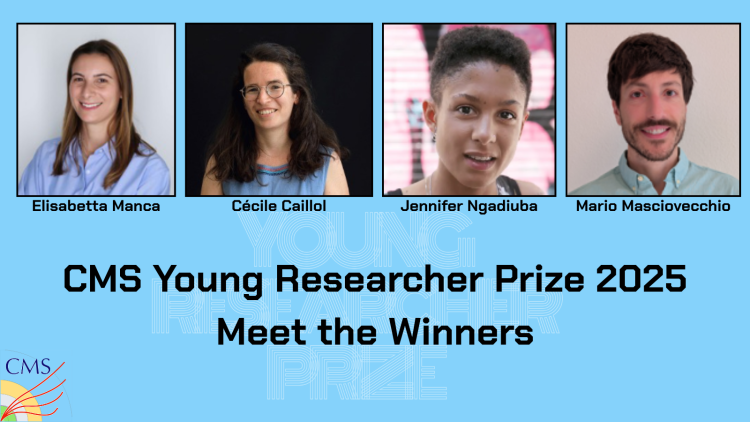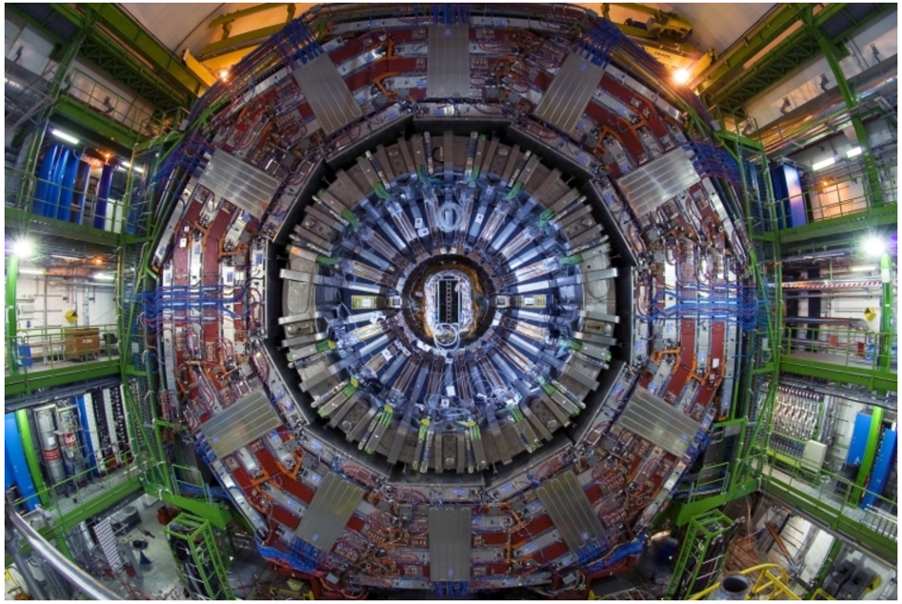
The CMS Collaboration announced the 2025 Young Researcher Prize winners during the September 2025 CMS Week. The winners are: Cécile Caillol, Elisabetta Manca, Mario Masciovecchio, Jennifer Ngadiuba!
This award recognises the contributions of truly exceptional young researchers in the CMS experiment. It is a moment to celebrate their dedication, innovation, and significant impact on the field of particle physics. By honouring these talented individuals, the collaboration aims to inspire future generations of scientists to push the boundaries of knowledge.
A huge congratulations to the winners!

Cécile Caillol
CERN, Switzerland. Ph.D:, Brussels, Belgium
"For her crucial and sustained contributions to BSM scalar searches, SM Higgs to ττ measurements, convening the L1 Trigger offline software group, and contributing a plethora of original analyses including of Run 3 data."
When I joined CMS, the Higgs boson had just been discovered but we still did not know whether it coupled to fermions. I focused a large part of my research work on observing Higgs boson decays to tau leptons, and later on measuring the Higgs boson properties using the ditau decay channel. I also explored whether the Higgs boson decayed through channels not predicted in the standard model, without any evidence so far. Beyond my Higgs-related research, I performed many analyses targeting rare standard model processes, as well as beyond-the-standard model particles. In particular, I recently searched, using the fresh Run-3 data, for particles that would cross the CMS detector very slowly, using a novel triggerless system called the Level-1 Scouting. In parallel of my data analysis work, I have been involved in the Level-1 trigger project for 10 years, and the prize recognises my contributions as offline software convener, coordinating the software developments of the Level-1 trigger project and integrating them into the central CMS software.

Elisabetta Manca
UCLA, USA. Ph.D.: Scuola Normale Superiore. Pisa, Italy
"For her crucial and sustained contributions to the W mass measurement involving muon track reconstruction, momentum scale calibration, and extraction of helicity cross sections."
My research is focused on precision electroweak measurements, which have become a crucial tool in the search for new physics in the era after the Higgs discovery. When direct evidence for new particles remains elusive, even small discrepancies with the Standard Model can open the path to discoveries. Over the past decade, I have played a central role in the high-precision measurement of the W boson mass, a project that has accompanied my academic journey from student to postdoctoral researcher.
My main contributions include calibrating the CMS tracker with a precision better than one part in ten thousand—the most accurate achieved during the experiment’s data taking—and developing the helicity fit, an analysis that infers the W-boson production model directly from the observed data. This approach provided a key validation of the main W-mass result and, crucially, a proof of principle for future model-independent precision measurements at the LHC.
What motivates me is the challenge of reaching such levels of precision: questioning established methods, solving problems that may not have obvious solutions, and pushing the boundaries of what we can learn about the universe. Ultimately, I believe that precision physics is one of the best chances we have to uncover the cracks in the Standard Model and to shed light on open questions such as the nature of dark matter.

Mario Masciovecchio
UCSD, USA. PhD.: ETH, Switzerland
"For his crucial and sustained contributions to dark matter searches, developing a pattern recognition algorithm for modern computing architectures, and convening the SUSY group."
Having joined CMS as a Summer Student in 2011, and having been a member of the collaboration since then, I was lucky enough to be involved in many areas of the experiment. After the discovery of the Higgs boson in 2012, when I was a M.S. 's student, my primary research activities have been two-fold.
On the one hand, I use the collision data collected with the CMS experiment to probe the standard model (SM) of particle physics, the properties of the Higgs boson itself (e.g., its couplings to other fundamental particles) and the existence of physics beyond the SM (BSM). We know that only about 5% of the universe is made of ordinary matter, while the remaining 95% consists of so-called dark matter and dark energy. Dark matter candidates are predicted by a range of BSM theories, one of the most notable being supersymmetry (SUSY). In my work, I search for signatures of dark matter that may be produced in the proton-proton collisions collected at CMS, and I convened one of the groups where these searches are conducted. While there was no evidence of BSM physics so far, the data collected during the LHC Run 3 and the High-Luminosity LHC era that will follow represent a unique opportunity to keep searching for it!
On the other hand, the large amount of data collected at high rate by large-scale experiments like CMS, together with the finite availability of computing and storage resources, imply that the reconstruction algorithms in use, that include novel machine learning techniques, must evolve to fully exploit the modern processor architectures. My work focuses on the development of the algorithms used to reconstruct charged particle tracks using the information from the CMS tracker detector, and I currently convene the group that coordinates such activities in the CMS collaboration. One of the algorithms that I co-develop(ed), mkFit, is currently used for the track reconstruction in CMS, and its deployment in 2022 allowed to significantly speed up the total event reconstruction. There is still a lot of work to do, for the rest of the LHC Run 3 and the High-Luminosity LHC, and I am excited to be part of it!

Jennifer Ngadiuba
FNAL, USA. PhD.: Zurich, Switzerland
"For her crucial and sustained contributions to Machine Learning, an area in which she is considered a world leader, searches for anomalous jets, real-time anomaly detection in the L1 trigger and convening the new CMS ML group."
My research focuses on developing and deploying machine learning (ML) algorithms for real-time data analysis in the CMS hardware (Level-1) Trigger with the goal of enabling new ways to discover physics beyond the Standard Model. I work on integrating ultra-fast ML on the Field Programmable Gate Arrays (FPGAs) that make the L1 trigger system, where we must make decisions in less than a microsecond. These methods allow us to identify anomalous or unexpected events that could point to new phenomena, pushing the boundaries of what we can capture and study in high-energy collisions.
Throughout my career, from my early work at CERN and Caltech to my current position as a Wilson Fellow at Fermilab, I have been driven by the challenge of bringing AI to the frontier of experimental physics. I helped develop hls4ml, one of the first frameworks enabling sub-microsecond ML inference on FPGAs, and led the deployment of the first deep neural network for real-time anomaly detection in the CMS L1 trigger system. As the convenor of the CMS Machine Learning Group and Level-1 Trigger Detector Physics Group, I strive to foster collaboration across physics, computing, and engineering communities to design the next generation of intelligent detectors. My work is guided by a simple motivation: to make our experiments more adaptive, autonomous, and capable of discovering the unexpected—unlocking new insights into the fundamental laws of nature.
Watch our winners share their advice to other young researchers and tell us a little about themselves here:
Further links:
Find all the photos of the award ceremony here
Find the interviews video here

